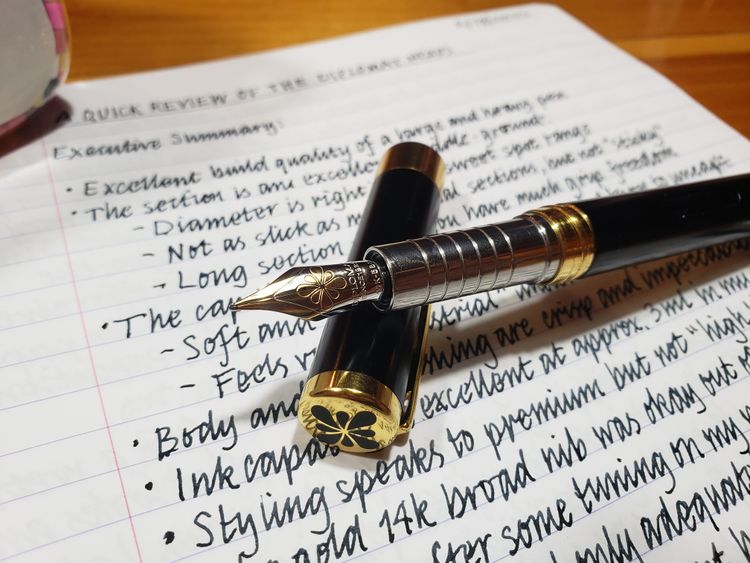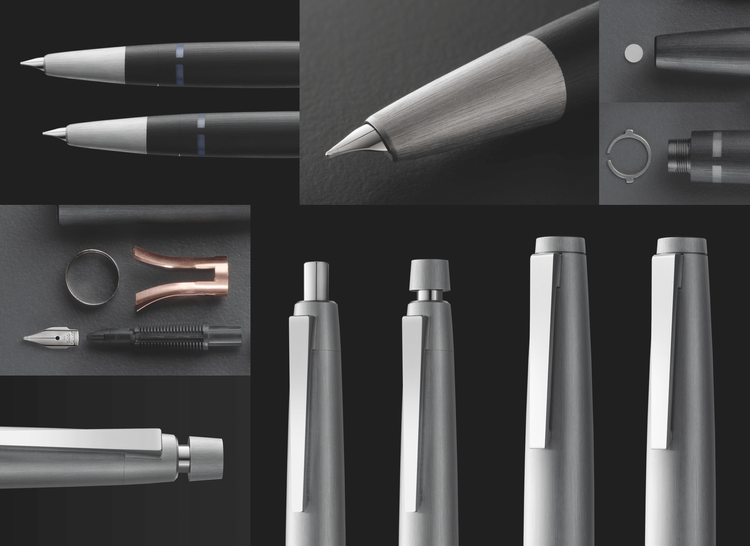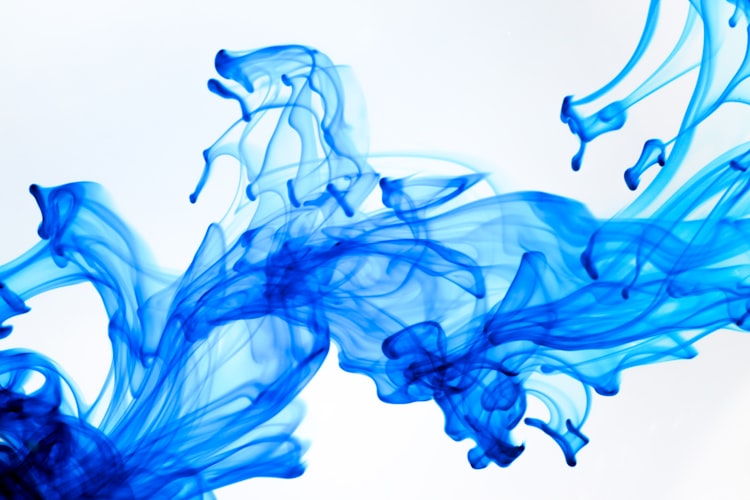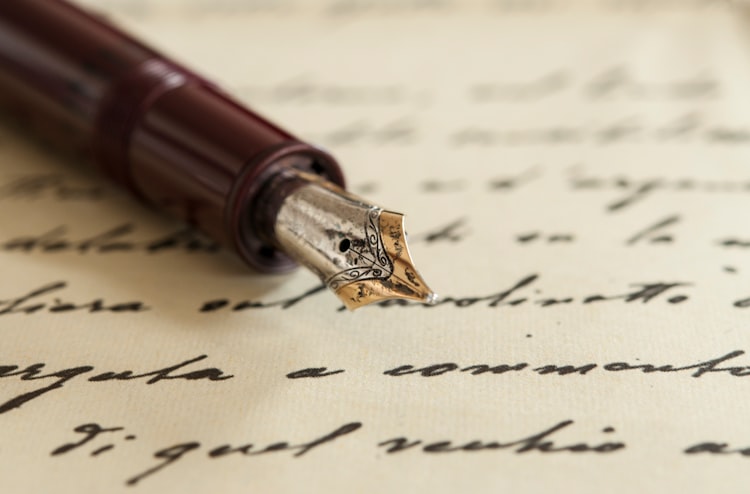How I ended up with a Lamy Aion
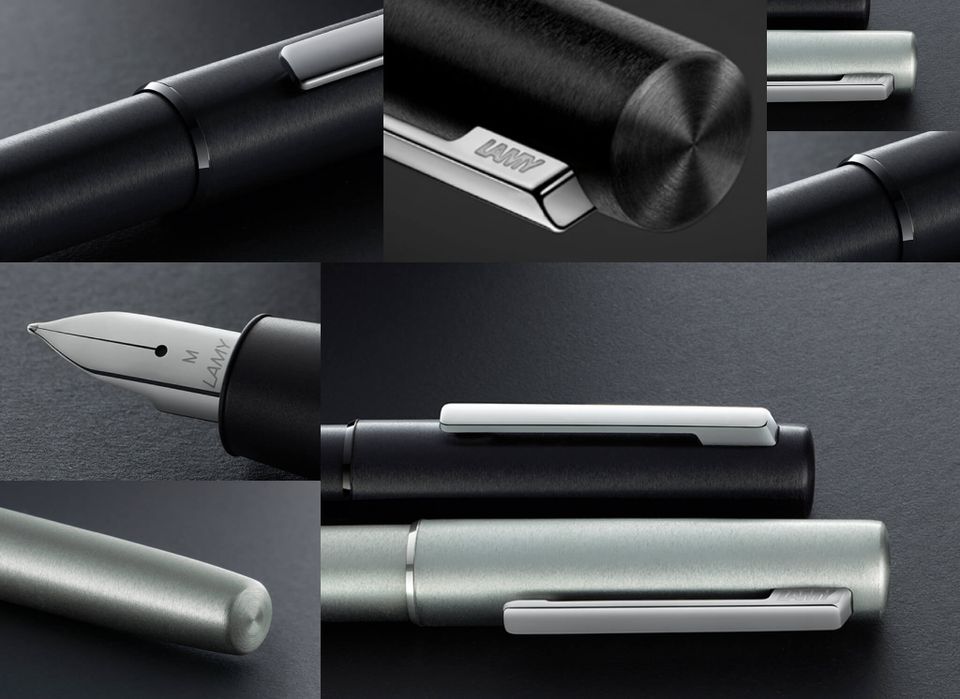
There are some pen brands that I seem to take to right away. Others take a more nebulous road. I have probably spent more years of my life using Montblanc pens than any other, as I received one as a generous gift when I was younger, and that one single pen served as my main and sometimes only inked pen for many years after. My first pen was a Waterman, and that experience has undoubtedly shaped my view of pens since. My mother's Sheaffer that she had such a fondness for really anchored my perception of the fountain pen as the premier tool for putting ink on the page.
I spent a long time with my Waterman and my Montblanc. Both these and the Sheaffer my mom used were wet writing pens. I used only Montblanc and maybe a touch of Monteverde ink my pens for most of that time. That eventually changed and I uncovered Goulet Pens and a world of inks. Naturally, Noodler's entered my radar and I loved it. This did not at all reduce the wet and juicy experience I had.
Maybe if I had started with a different set of pens and inks my feelings might be different now, but the reality is that I started pretty high up on the fountain pen food chain, and I am sure that this has colored all my experience since.
Eventually, though, I came to try other brands of pens and try to make use of them in earnest. It took Spencerian penmanship and the glory of a good flex nib to do it. I picked up a nicely tuned Spencerian grind Pilot Falcon that alternated with my Montblanc as my do everything pen. Then came the Montblanc Calligraphy and I found myself unhinged.
What an amazing pen! But the flood of possibility opened up and soon new pens from Pilot, Platinum, and Sailor were making their way into my collection. I had pens from Monteverde and Visconti as well, but what really made the difference with these new purchases was my strong interest in using them as my daily pens. And having spent some time with these pens, there are real patterns that have emerged, clearly modeling my early interests and long exposure to Waterman and Montblanc.
I have come to learn that feedback or no feedback does not matter to me as much, but wetness does. I realize now how much I do not enjoy mixing pen brands; the idea of a Sailor ink in a non-Sailor pen is strangely unappealing to me. I like to know and experience a pen as a unit in a system, and I like that system to feel congruent. I realized how much I like the wetness of a good pen and ink combination. I have come to appreciate a bold and solid line on the page and plenty of ink. I have come to really appreciate an element of refinement and attention to detail over more flashy elements. All the pens I have made significant use of for any serious period of time have been medium-size or wider, and I really enjoy the larger pens more.
You will note the absence of Lamy in my list of names above. Lamy is one of those nebulous brands for me. For the longest time, I have been near Lamy pens, as they are one of the more popular pens in use with my family, but I never really made use of them myself. I had some respect for the brand, but I could never quite bring myself to pick one up.
Looking at my other options, the answer is a little more clear. All my new pens of interest were bought because of their nibs. I bought a MB Flex. The Pilots are all unique nibs (WA, SU, Spencerian). The Platinums all have unique nibs (Music, UEF). The Sailor pens are known for their nibs, and their 21K KOP nibs are really something not only to look at but also to feel on the page.
But Lamy is different. Lamy pens are unique all over, from their nibs to their design to the aesthetic to the materials and engineering. But they aren't the sort of pens to make someone with gold Italic and Music and Flex nibs as the backbone of his collection go, "Wow, I want one of those pens!" Even my Montblanc 146 that I have had all these years has an architect-like EF nib. And I also cannot help but notice all the reports of nib and flow and other issues related to Lamy. I guess in my head somewhere I kept writing Lamy off as not "refined" enough for me. Lamy was the easy, low maintenance option that my family members could use and abuse, since they didn't care about flex nibs or stubs or any of that. Surely Lamy wasn't for me, whose set of daily writing pens had much more attention and hand work that went into them (and often had prices to match).
But my mind knew that was a lie even as it thought it. From start to finish, I have found myself looking and watching. I would find myself thinking about Lamy pens and reading about them and browsing their line-up of pens. I would get a feeling and start pondering, "Maybe I should get a Lamy...." But then a bad review would turn me away again. Ironically, it was the Pilot SU nib that eventually got me started towards the path. Before that, it was EF needlepoints and Spencerian or Palmer penmanship for me. I picked up a SU nib on a whim. Of course, I was not about to use Spencerian with such a nib, so I used Italic. I inexplicably found myself having a real blast. The thicker line brought me back to those days with my wet writing Waterman (M) and the delicious line on the page. That lead to the Music nib and a new B nib for a family member had me sit up and take notice. Suddenly a Sailor KOP B made a lot more sense. And that pen, coupled with the very wet Sailor inks is truly a pleasure to use.
The next time I found myself thinking about Lamy pens they were much more attractive to me. I still had to let myself pass on an Aion though. I remember how much the lines drew me in and that sleek but measured minimalist aesthetic seemed at the same time so "boring" and yet resulted in something my mind continued to return to. But I left off again because of reviews I read about loose caps. The Lamy 2000 kept calling, but this time I knew I liked a bigger pen and I wasn't sold on the muted makrolon finish or the hooded nib. I think the Lamy 2000 has a more negative energy compared to the Aion that seems to have some kind of positive energy.
In the end, my first Lamy had to be a Dialog 3. There really wasn't any chance for something else. This was Lamy's chance to convert me from distant and aloof, somewhat reluctant admirer into a rabid fanboy. Unfortunately, it did not go that way.
The first Dialog 3 I had just would not flow well. After the joyful wet writing of my Sailor, and the consistency of my Platinum pens, or the sure predictability of Pilot, it was a rude shock to encounter any sort of real problems with a pen. I had to have the pen replaced, and the replacement finally let me experience something of the normal Lamy experience. But all my efforts to make my Dialog 3 work for me taught me a lot, and much of it relates to Lamy nibs.
The Lamy nibs I picked up demonstrate both the strength and weakness of Lamy. I easily picked up a number of gold and steel nibs that I can use and install very easily. It is so nice. But all the nibs that I ordered for my Dialog 3 or that came on my Dialog 3 units were not at all my idea of well-tuned. I have never had to adjust or tune any of my nibs that I got from Waterman, Montblanc, Pilot, Platinum, Sailor, Visconti, or Monteverde. But with my Dialog 3, I had to adjust every one of them.
In the end, though, I did get the Dialog 3 that I wanted from the outset, and I eventually found myself again examining the Lamy Aion. Only now I had more confidence. Now I was pretty sure I could handle the Lamy, and what's more, the model just kept getting to me. A few final tugs and I found myself in possession of a perfect specimen.
From my experience with the Dialog 3 I now had a few expectations and a few questions. I expected impeccable basic engineering and construction. I expected a small pen. I expected an okay but maladjusted nib and feed. I wondered whether my experience with my Dialog 3 was just a fluke or something systemic. I wondered if the "loose" cap problem was a real problem or not. I wondered if such a pen would really be able to hold its own in my collection, despite my continual stalking from afar. I wondered if the grip would be slippery or if the pen's posting would make a difference. I wondered if the pen would make quick writing sessions easier and more convenient while not impairing long writing sessions. I wondered if I could really make a Lamy a daily use replacement (recall that I mostly just focus on using one pen at a time and do not like to switch between pens) of all my other pens. Would a snap cap pen really be to my liking when so many of my pens are twist/screw-type caps?
When I opened up my new pen, I spent some time going over it and found the pen, amazingly, in what appeared to be perfect order, and it was more impressive than I had hoped for. For some reason, I had in my head a smaller pen, but the Aion is bigger, and longer. Thank Jasper Morrison for that, says I! The larger size is so much more up my alley than the smaller and skinnier options. And the section does not taper too much, so the pen sits well in my hand. The fit and finish, IMO, is impeccable, and many of the elements are durable metal on metal designs as opposed to potentially less durable metal on plastic. But there are also signs of excellent consideration of the finish of the pen since the cap has an inner protective cap sleeve that helps keep it from scratching the barrel. In short, I was pleased with the presence of the pen and the style and quality it exudes. The brushed aluminum gives a semi-matte texture without becoming dull. The lines, weight, balance, and form are all much better in person than even how they appealed to me online. Jasper has walked a nice balanced tight rope between a modern and sleek design and ensuring sufficient softness to be still open and inviting to the human emotional center. it is not too harsh, while not giving up the more vibrant and intense presence facilitated by the use of brushed metal. IMO, the Aion manages to preserve and maybe even enhance the gravitas of the Lamy 2000 without the accompanying dowerness. The pen signals convention and conservatism while introducing subtle hints at a contrarian soul. It is a formal sort of pen that has a fun and slightly casual spirit.
And maybe this is where Lamy, and IMO, the Aion, sine brightest among their competition. The Lamy design captures passion and beauty through restraint and attention to detail rather than flashy exuberance. They won't always grab your attention fastest, but the confidence and comfort over time is there.
And while we are heaping on piles of praise for the Aion, let me cover a few non-issues for me. The cap fitment is the elephant in the room. Yes, there is play in the cap and barrel fit when closed, and no, I do not think it detracts from the pen in any way. I do not have a single snap cap pen that does not have some play or that does not allow the body of the pen to rotate while capped, including the Lamy 2000. No, the Lamy 2000 snap feel is not cleaner or neater (it's actually mushier) nor more substantial. Yes, the Aion rotates more freely than the 2000, but that almost feels better to me than the grindy nature of the 2000. I consider it an aesthetic and functional non-issue at this point. The only exception to this for snap caps is my Waterman Exception, and its square section makes it an...Exception. Moreover, a little space in the cap means that there is little to no pressure on the cap-barrel contact points to cause wear on either the internal protective sleeve or the barrel itself. I just do not see the big deal with the cap fitment.
Next is the issue of loose cap posting. The cap can post, but this is another non-issue because I do not think the pen was designed to be posted. It works, sure, but the length of the pen body indicates to me that this pen was designed first and foremost to be used unposted. The length of the body is nearly as long as many of my pens when they are posted, including big pens like my MB 149 and my Sailor KOP. If you examine the pen as a pen meant to be used unposted, the fact that it will post in a pinch is just a bonus. But the brushed aluminum of the body has the potential to cause internal wear on any plastic components in the cap, so I just don't think it's a good idea to regular post the pen.
The final non-issue is the grip. It is not slippery. There, glad we dealt with that.
And that was not the only good news with this pen. I have come to expect a poor initial nib from Lamy because their nibs seem intentionally tuned in a way that I do not like, but to my surprise, the Aion nib I got was very well adjusted. It had good tine spacing and a very nice, smooth, stiff nib. It was more than I had hoped for in that nib. I think I had one other steel nib from Lamy tuned like this Aion nib, and another tuned how all my Lamy gold nibs came (way too tightly spaced in the tines), so I am not sure what the actual rate of "good" to bad is relative to my preferences. Even though I had planned for a gold nib on the pen from the start, it was nice to see a good Lamy nib out of the box.
I wish it were all smooth sailing from there, but I am afraid not. I had high hopes for the initial writing, but I soon learned that my Aion was having similar, if less severe flow issues as the first Dialog 3 I had sent back. But this time, I was determined to test a theory. I suspected that these pens were susceptible to low flow if the test ink did not fully rinse after the writing testing from Lamy. The idea I had was that simply continuing to cycle ink through the pen by writing might clean out the pen and get the flow going. This was quite frustrating, but I think in this case it mostly seems to have worked. I have read reports of other people trying the same thing to some success. I also took a gold B nib and made it a little wetter and installed it on the Aion instead of the default nib since I wanted to get a broader and wetter stroke.
However, comparing it against a Lamy 2000, the Aion was still not wet enough, so I daringly stretched that B nib to the absolute limits of what I'm willing to do with the nib to make it write much wetter, all while only doing ink and water-based flushing and writing with the pen. I did use some non-Lamy inks in this process, just to compare the relative flows between other inks and Lamy's own inks, so my testing is not fully able to determine whether just doing this with Lamy inks alone will work (which is what I want to be able to say). However, now that I have the gold B nib riding the absolute ragged edge, I have something that is just about on par with my Lamy 2000 (B nib).
Overall, after much frustration, the ink seems to flow well, and the feed seems to be able to mostly keep up. I did use some wetter non-Lamy inks to see fi the pen had any chance at all and they worked, though much more dryly before I further tuned the gold nib than is typical for those inks. The Lamy inks are now working successfully in the pen with sufficient wetness as well, so I feel that progress has been good and I can only anticipate a better experience with the pen from here on out. Frankly, though, to get here was much more work than it should have been to have a decent writing experience. The good thing is that the Lamy nibs are accessible and easy enough to work on that I felt comfortable getting the nibs to the place that I wanted them, but really, should this have been necessary?
This means that each of my Lamys has required me to make some adjustment of the nib to get something that would work for me (and I have always done a bit of that with the pens that my family has used as well). The good news is that I was able to do so without anything more drastic than tine spacing and alignment, but with so many of my other pens coming to me perfectly adequate out of the box and without requiring me to adjust the nibs, is the Lamy magic worth all the manual attention? I do have a Lamy 2000 where I have not done this, but I am not sure that there is anything I could do to that nib that would improve it, but I'm also not sure I would consider it an adequate and appropriate nib.
Where does that leave me? Well, right now I am penning this essay with my Lamy Aion with the gold nib and Lamy Black ink. I have continued to feel my comfort and confidence in Lamy increase the more time I spend with the brand. For example, I am coming to a surprising appreciation of Lamy inks. But I still cannot tell if this is one of those relationship that starts off rough and grows into something beautiful or just a toxic one that just gets more and more painful to leave because of all the good elements.
Still, there is no doubting that there is some sort of magic here, because any other brand would have long since seen the door. And even though I think the Aion is a much better looking pen than the Lamy 2000, I had to get a Lamy 2000 to try, because, well, I have to know! But for now, the Lamy Aion is still my fascination and still singing in my hands. I just cannot seem to let it go.
